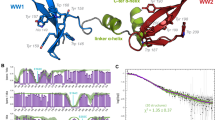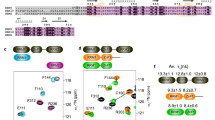Abstract
Polypyrimidine tract–binding protein (PTB) is a regulatory splicing repressor. Raver1 acts as a PTB corepressor for splicing of α-tropomyosin (Tpm1) exon 3. Here we define a minimal region of Raver1 that acts as a repressor domain when recruited to RNA. A conserved [S/G][I/L]LGxxP motif is essential for splicing repressor activity and sufficient for interaction with PTB. An adjacent proline-rich region is also essential for repressor activity but not for PTB interaction. NMR analysis shows that LLGxxP peptides interact with a hydrophobic groove on the dorsal surface of the RRM2 domain of PTB, which constitutes part of the minimal repressor region of PTB. The requirement for the PTB-Raver1 interaction that we have characterized may serve to bring the additional repressor regions of both proteins into a configuration that allows them to synergistically effect exon skipping.
This is a preview of subscription content, access via your institution
Access options
Subscribe to this journal
Receive 12 print issues and online access
$189.00 per year
only $15.75 per issue
Buy this article
- Purchase on Springer Link
- Instant access to full article PDF
Prices may be subject to local taxes which are calculated during checkout







Similar content being viewed by others
References
Lareau, L.F., Green, R.E., Bhatnagar, R.S. & Brenner, S.E. The evolving roles of alternative splicing. Curr. Opin. Struct. Biol. 14, 273–282 (2004).
Cartegni, L., Chew, S.L. & Krainer, A.R. Listening to silence and understanding nonsense: exonic mutations that affect splicing. Nat. Rev. Genet. 3, 285–298 (2002).
Matlin, A.J., Clark, F. & Smith, C.W. Understanding alternative splicing: towards a cellular code. Nat. Rev. Mol. Cell Biol. 6, 386–398 (2005).
Wagner, E.J. & Garcia-Blanco, M.A. Polypyrimidine tract binding protein antagonizes exon definition. Mol. Cell. Biol. 21, 3281–3288 (2001).
Conte, M.R. et al. Structure of tandem RNA recognition motifs from polypyrimidine tract binding protein reveals novel features of the RRM fold. EMBO J. 19, 3132–3141 (2000).
Simpson, P.J. et al. Structure and RNA interactions of the N-terminal RRM domains of PTB. Structure 12, 1631–1643 (2004).
Oberstrass, F.C. et al. Structure of PTB bound to RNA: specific binding and implications for splicing regulation. Science 309, 2054–2057 (2005).
Perez, I., Lin, C.H., McAfee, J.G. & Patton, J.G. Mutation of PTB binding sites causes misregulation of alternative 3′ splice site selection in vivo. RNA 3, 764–778 (1997).
Amir-Ahmady, B., Boutz, P.L., Markovtsov, V., Phillips, M.L. & Black, D.L. Exon repression by polypyrimidine tract binding protein. RNA 11, 699–716 (2005).
Shen, H., Kan, J.L., Ghigna, C., Biamonti, G. & Green, M.R. A single polypyrimidine tract binding protein (PTB) binding site mediates splicing inhibition at mouse IgM exons M1 and M2. RNA 10, 787–794 (2004).
Izquierdo, J.M. et al. Regulation of Fas alternative splicing by antagonistic effects of TIA-1 and PTB on exon definition. Mol. Cell 19, 475–484 (2005).
Wagner, E.J. & Garcia-Blanco, M.A. RNAi-mediated PTB depletion leads to enhanced exon definition. Mol. Cell 10, 943–949 (2002).
Gooding, C., Roberts, G.C. & Smith, C.W. Role of an inhibitory pyrimidine element and polypyrimidine tract binding protein in repression of a regulated alpha-tropomyosin exon. RNA 4, 85–100 (1998).
Lin, C.H. & Patton, J.G. Regulation of alternative 3′ splice site selection by constitutive splicing factors. RNA 1, 234–245 (1995).
Singh, R., Valcarcel, J. & Green, M.R. Distinct binding specificities and functions of higher eukaryotic polypyrimidine tract-binding proteins. Science 268, 1173–1176 (1995).
Chou, M.Y., Underwood, J.G., Nikolic, J., Luu, M.H. & Black, D.L. Multisite RNA binding and release of polypyrimidine tract binding protein during the regulation of c-src neural-specific splicing. Mol. Cell 5, 949–957 (2000).
Perez, I., McAfee, J.G. & Patton, J.G. Multiple RRMs contribute to RNA binding specificity and affinity for polypyrimidine tract binding protein. Biochemistry 36, 11881–11890 (1997).
Oh, Y.L. et al. Determination of functional domains in polypyrimidine-tract-binding protein. Biochem. J. 331, 169–175 (1998).
Monie, T.P. et al. The polypyrimidine tract binding protein is a monomer. RNA 11, 1803–1808 (2005).
Zhang, W., Liu, H., Han, K. & Grabowski, P.J. Region-specific alternative splicing in the nervous system: implications for regulation by the RNA-binding protein NAPOR. RNA 8, 671–685 (2002).
Charlet-B., N., Logan, P., Singh, G. & Cooper, T.A. Dynamic antagonism between ETR-3 and PTB regulates cell type-specific alternative splicing. Mol. Cell 9, 649–658 (2002).
Gromak, N., Matlin, A.J., Cooper, T.A. & Smith, C.W. Antagonistic regulation of alpha-actinin alternative splicing by CELF proteins and polypyrimidine tract binding protein. RNA 9, 443–456 (2003).
Polydorides, A.D., Okano, H.J., Yang, Y.Y., Stefani, G. & Darnell, R.B. A brain-enriched polypyrimidine tract-binding protein antagonizes the ability of Nova to regulate neuron-specific alternative splicing. Proc. Natl. Acad. Sci. USA 97, 6350–6355 (2000).
Markovtsov, V. et al. Cooperative assembly of an hnRNP complex induced by a tissue-specific homolog of polypyrimidine tract binding protein. Mol. Cell. Biol. 20, 7463–7479 (2000).
Yamamoto, H., Tsukahara, K., Kanaoka, Y., Jinno, S. & Okayama, H. Isolation of a mammalian homologue of a fission yeast differentiation regulator. Mol. Cell. Biol. 19, 3829–3841 (1999).
Gooding, C., Kemp, P. & Smith, C.W. A novel polypyrimidine tract-binding protein paralog expressed in smooth muscle cells. J. Biol. Chem. 278, 15201–15207 (2003).
Huttelmaier, S. et al. Raver1, a dual compartment protein, is a ligand for PTB/hnRNPI and microfilament attachment proteins. J. Cell Biol. 155, 775–786 (2001).
Gromak, N. et al. The PTB interacting protein raver1 regulates alpha-tropomyosin alternative splicing. EMBO J. 22, 6356–6364 (2003).
Robinson, F. & Smith, C.W.J. A splicing repressor domain in polypyrimidine tract binding protein. J. Biol. Chem. 281, 800–806 (2006).
Xia, Z. & Liu, Y. Reliable and global measurement of fluorescence resonance energy transfer using fluorescence microscopes. Biophys. J. 81, 2395–2402 (2001).
Hahm, B. et al. Polypyrimidine tract-binding protein interacts with HnRNP L. FEBS Lett. 425, 401–406 (1998).
Dominguez, C., Boelens, R. & Bonvin, A.M. HADDOCK: a protein-protein docking approach based on biochemical or biophysical information. J. Am. Chem. Soc. 125, 1731–1737 (2003).
Singh, R. & Valcarcel, J. Building specificity with nonspecific RNA-binding proteins. Nat. Struct. Mol. Biol. 12, 645–653 (2005).
Selenko, P. et al. Structural basis for the molecular recognition between human splicing factors U2AF65 and SF1/mBBP. Mol. Cell 11, 965–976 (2003).
Sharma, S., Falick, A.M. & Black, D.L. Polypyrimidine Tract Binding protein blocks the 5′ splice site dependent assembly of U2AF and the prespliceosomal E complex. Mol. Cell 19, 485–496 (2005).
Chan, D.C., Bedford, M.T. & Leder, P. Formin binding proteins bear WWP/WW domains that bind proline-rich peptides and functionally resemble SH3 domains. EMBO J. 15, 1045–1054 (1996).
Bedford, M.T., Chan, D.C. & Leder, P. FBP WW domains and the Abl SH3 domain bind to a specific class of proline-rich ligands. EMBO J. 16, 2376–2383 (1997).
Bedford, M.T., Reed, R. & Leder, P. WW domain-mediated interactions reveal a spliceosome-associated protein that binds a third class of proline-rich motif: the proline glycine and methionine-rich motif. Proc. Natl. Acad. Sci. USA 95, 10602–10607 (1998).
Wollerton, M.C., Gooding, C., Wagner, E.J., Garcia-Blanco, M.A. & Smith, C.W. Autoregulation of polypyrimidine tract binding protein by alternative splicing leading to nonsense-mediated decay. Mol. Cell 13, 91–100 (2004).
Roberts, G.C., Gooding, C., Mak, H.Y., Proudfoot, N.J. & Smith, C.W. Co-transcriptional commitment to alternative splice site selection. Nucleic Acids Res. 26, 5568–5572 (1998).
Tian, M. & Maniatis, T. A splicing enhancer exhibits both constitutive and regulated activities. Genes Dev. 8, 1703–1712 (1994).
Kleinhenz, B. et al. Raver2, a new member of the hnRNP family. FEBS Lett. 579, 4254–4258 (2005).
Gordon, G.W., Berry, G., Liang, X.H., Levine, B. & Herman, B. Quantitative fluorescence resonance energy transfer measurements using fluorescence microscopy. Biophys. J. 74, 2702–2713 (1998).
Johnson, B.A. & Blevins, R.A. NMRVIEW—a computer program for the visualization and analysis of NMR data. J. Biomol. NMR 4, 603–614 (1994).
Delaglio, F. et al. NMRPipe: a multidimensional spectral processing system based on UNIX pipes. J. Biomol. NMR 6, 277–293 (1995).
Acknowledgements
We thank J. Valcárcel for helpful comments on the manuscript, B. Jockusch for Raver1 monoclonal antibodies and I. Moss, of the Advanced Biotechnology Centre, Imperial College London, for technical advice and for preparation of the peptides. This work was funded by Wellcome Trust program grant 059879 to C.W.J.S. A.P.R. was supported by a Wellcome Trust Prize studentship. S.M. and S.C. are also indebted to the Wellcome Trust for grant support (078209). S.H. and M.L. were supported by US National Institutes of Health grant AR 41480 to R.H.S.
Author information
Authors and Affiliations
Contributions
A.P.R. mapped the Raver1 repressor domain and identified and characterized the PTB-interacting motif. C.G. did pull-down experiments identifying multiple PTB-interacting segments of Raver1, and some transfections. C.W.J.S. directed these experiments, coordinated the collaborations and wrote the first draft of the manuscript. S.M. and S.C. coordinated design of structural experiments. T.P.M. expressed and purified all PTB constructs; P.J.S. and S.M. planned and executed NMR experiments and data analysis. R.H.S. coordinated the FRET experiments. S.H. tested FRET with full-length Raver1. M.L. carried out all other FRET experiments. All authors contributed to writing and redrafting the manuscript.
Corresponding author
Ethics declarations
Competing interests
The authors declare no competing financial interests.
Supplementary information
Supplementary Fig. 1
R442–629-MS2 activity in the presence of mutations in PTBP-binding sites within the P3 pyrimidine tracts of TPM1. (PDF 122 kb)
Supplementary Fig. 2
NMR binding isotherms for the titration of different PTB constructs with Raver1 peptides and RNA. (PDF 169 kb)
Supplementary Fig. 3
Per-residue chemical shift change in RRM2 upon initial addition of Raver1 peptide and subsequent RNA titration. (PDF 239 kb)
Supplementary Fig. 4
2D 1H-15N HSQC titration of Raver1 peptide with PTBP1-2, illustrating progressive broadening of peptide backbone signals. (PDF 86 kb)
Supplementary Fig. 5
Titration of PTB1-2 with full-length peptide Raver1491–511 and a truncated version containing only the core motif SLLGEPPA, and paramagnetic relaxation enhancement for 15N-labeled PTBP-RRM2 in complex with spin-labeled Raver1 peptides. (PDF 894 kb)
Supplementary Fig. 6
The Raver1-binding site of PTBP1 RRM2, highlighting the position of Leu500 and Leu501 of Raver1. (PDF 416 kb)
Rights and permissions
About this article
Cite this article
Rideau, A., Gooding, C., Simpson, P. et al. A peptide motif in Raver1 mediates splicing repression by interaction with the PTB RRM2 domain. Nat Struct Mol Biol 13, 839–848 (2006). https://doi.org/10.1038/nsmb1137
Received:
Accepted:
Published:
Issue Date:
DOI: https://doi.org/10.1038/nsmb1137
This article is cited by
-
Structural basis of the interaction between SETD2 methyltransferase and hnRNP L paralogs for governing co-transcriptional splicing
Nature Communications (2021)
-
Splicing repression is a major function of TDP-43 in motor neurons
Acta Neuropathologica (2019)
-
Structure of the RBM7–ZCCHC8 core of the NEXT complex reveals connections to splicing factors
Nature Communications (2016)
-
HnRNP C, YB-1 and hnRNP L coordinately enhance skipping of human MUSK exon 10 to generate a Wnt-insensitive MuSK isoform
Scientific Reports (2014)
-
HnRNP L and hnRNP LL antagonistically modulate PTB-mediated splicing suppression of CHRNA1 pre-mRNA
Scientific Reports (2013)



